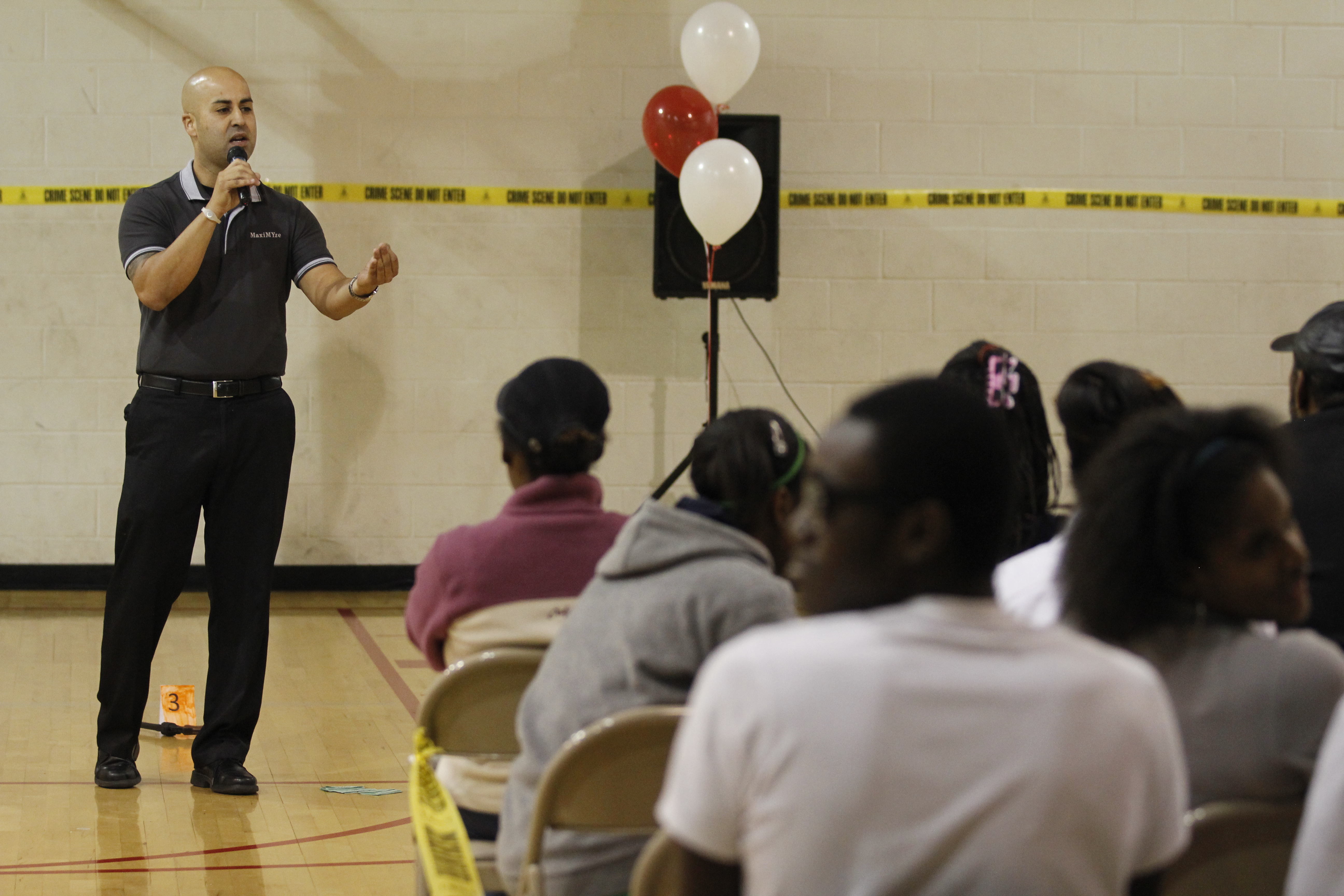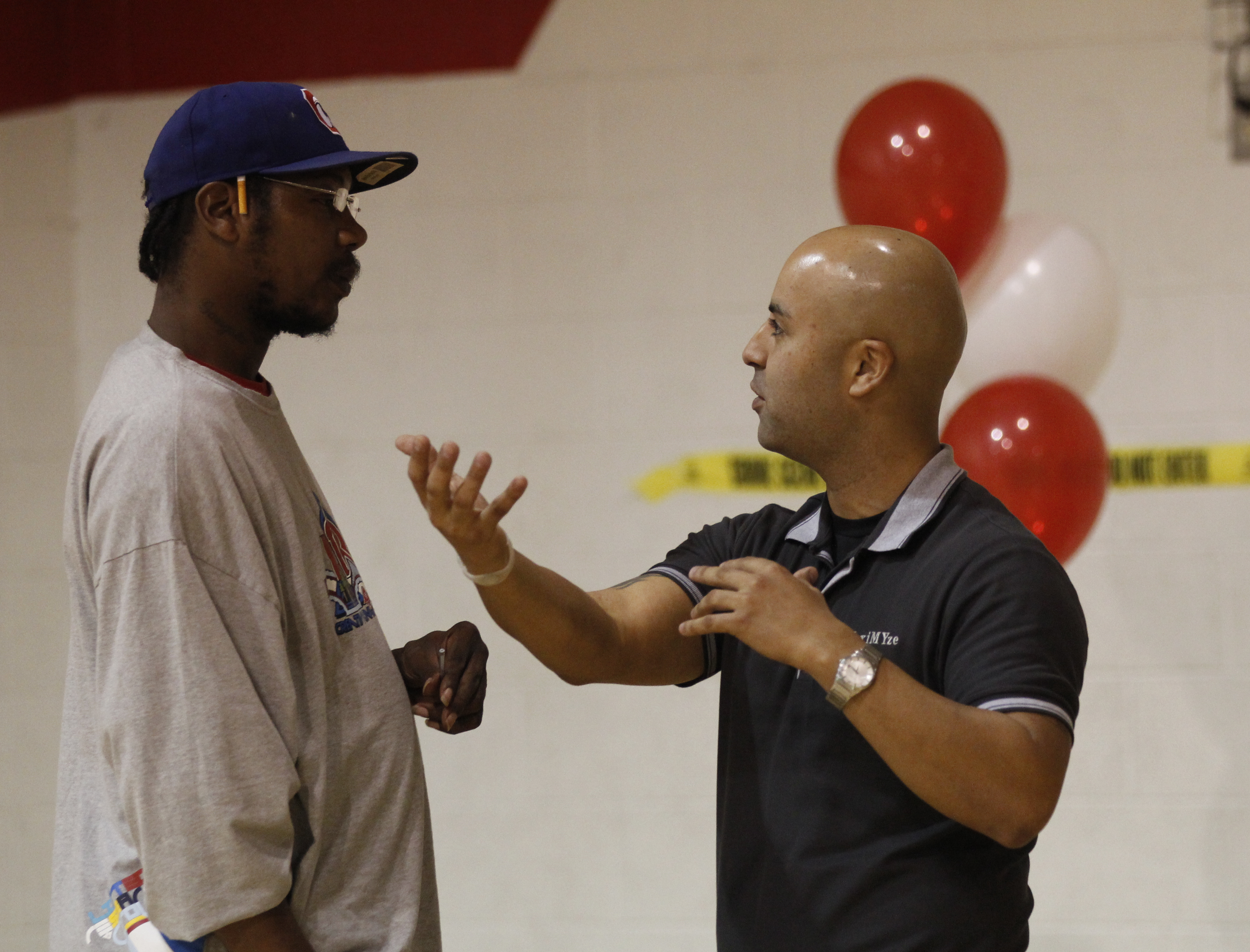Fighting Chattanooga's gang problem with words
Tuesday, October 16, 2012
 Jose Perez speaks to a crowd gathered at the first night of the Stop the Violence Campaign rally at the Salvation Army in Chattanooga on Monday night. Perez, a former drug dealer who was sent to federal prison, is now a partner with the Gang Task Force and acts as a link to Hispanic communities in the city.
Jose Perez speaks to a crowd gathered at the first night of the Stop the Violence Campaign rally at the Salvation Army in Chattanooga on Monday night. Perez, a former drug dealer who was sent to federal prison, is now a partner with the Gang Task Force and acts as a link to Hispanic communities in the city. Jose Perez, right, talks to Rodrick McGee after speaking at the first night of the Stop the Violence Campaign rally at the Salvation Army in Chattanooga on Monday night. Perez, a former drug dealer who was sent to federal prison, is now a partner with the Gang Task Force and acts as a link to Hispanic communities in the city.
Jose Perez, right, talks to Rodrick McGee after speaking at the first night of the Stop the Violence Campaign rally at the Salvation Army in Chattanooga on Monday night. Perez, a former drug dealer who was sent to federal prison, is now a partner with the Gang Task Force and acts as a link to Hispanic communities in the city.FAST FACTS• From 2000 to 2010, the Hispanic population in Chattanooga grew by 181 percent < increasing from 3,281 to 9,225 people.• Hispanics represent 4.5 percent of the population in Hamilton County and 5.5 percent of Chattanooga's population.• Hispanics live predominantly in southern Hamilton County: Highland Park, Clifton Hills and East Lake.• The Hispanic population in Hamilton County is predominantly Guatemalan in origin, followed by Mexican.• From 2006 to 2010, Hispanic school enrollment grew by 49.5 percent compared to the white rate of 1 percent and the black rate of -4.5 percent.• Education levels in Hispanic households tend to be low, but the percentage of Hispanics living in traditional family households is higher than for both whites and blacks.Source: Chattanooga Gang Assessment
Pérez finds change of heart in prison
José Pérez was born and raised in Los Angeles but moved to Chattanooga when he was 18 because he said he "chose the wrong kind of friends" in California.His choices didn't get much better. He started dealing drugs.On Dec. 7, 2004, the Cleveland, Tenn., Police Department used a confidential informant to arrange for the delivery of one kilo of cocaine from Pérez, according to court records. About 11 p.m. Pérez arrived at a parking lot in Bradley County but noticed law enforcement surveillance and tried to escape.After a high-speed chase on Interstate 75, Pérez turned off his headlights to try to elude law enforcement. He lost control of his vehicle when he tried to cross the median and hit a tree.He pleaded guilty to conspiracy to distribute 500 kilograms or more of cocaine and was sentenced to three years in prison and four years of probation. His probation was terminated in 2010 because of perfect behavior.In prison, Pérez said he sought God not because he wanted "a change of circumstance, but because he wanted a change of heart." He studied the Bible and participated in group therapy and other programs. He encouraged unity among Hispanics and the other inmate population and eventually became the chaplain's assistant.When he got out, he wanted to continue making a difference and give back to the community he helped destroy.He enrolled at Chattanooga State Community College, where he earned an associate of science degree and made the dean's list. Perez is a semester away from completing his bachelor's of arts degree in psychology at UTC.He ministers to inmates, speaks in schools for Prison Prevention Ministries and this year founded MaxiMYze, an outreach organization that uses a psychological approach to address problems and inspire unity.Now he wants to apply all of those skills toward gang prevention. As a partner with the Gang Task Force, he wants to talk to at-risk youth at schools, intervene with gang members in jails and run literacy programs in the community.The goal is to interrupt violence and promote multicultural unity, he said."A lot of the youth I'm trying to target come from fragmented families," he said. "When you deliver these seeds of impact, there's no telling the amount of growth that can come out of it."
Reaching out to the Hispanic population today is key to solving Chattanooga's gang problem tomorrow, says the head of the city's Gang Task Force.
"In the next 15 to 20 years, we are going to have a completely different Chattanooga ... the Hispanic population is going to be central to what goes on in the city," task force coordinator Boyd Patterson said.
The number of Hispanics in Chattanooga almost tripled from 2000 to 2010 and now represents 5.5 percent of the total population, but Hispanic children make up about 9 percent of the population under 5 years of age, according to the Chattanooga Gang Assessment.
Community leaders need to create deeper ties to Hispanic communities to develop programs to address the gang problem, although this goal will not be easy to accomplish because many Hispanics distrust the government, police and authorities, the assessment states.
"There are so many positive sources of support, so many folks in the Hispanic community who care about their family and greater Chattanooga, now it's time to start having a dialogue on a larger scale," Patterson said.
The gang task force is launching its Hispanic initiative with a Nov. 3 anti-gang literacy event that will combine Halloween and Día de los Muertos - the Day of the Dead - a Mexican holiday in which family and friends gather to pray for and remember loved ones who have died.
The goal, said José Pérez, a key partner with the Gang Task Force to handle outreach and multicultural or Hispanic affairs, is to promote literacy and bridge communities in Chattanooga, especially the East Lake area, one of the hotbeds for gang activity.
About 70 percent of prison inmates nationwide are illiterate, Patterson said.
"Literacy is something that not only helps bridge gaps between cultures but between individuals and opportunity," he said.
Pérez, who earned an associate degree at Chattanooga State Community College, said being in school created new opportunities for him.
The experience, he said, also opened his eyes to several issues in the community.
"I noticed a lack of literacy, undeveloped potential among people in the community, high dropout rates, domestic violence, fragmented families, gang violence, ex-inmates returning to jail, and a huge need for positive rolemodels in the inner city among African-American and Hispanics," he said.
Patterson said Pérez and people like him, who have "been there done that, who can walk up to a gang member and in 90 seconds know if the guy is a pretender or hardcore," are key to the fight against gangs.
"The only way we are going to make large-scale progress in this city is to have a large-scale collaboration among people whose hearts are in the right place and with skill sets that enable them to make a difference," he said.
According to the citywide gang assessment, Chattanooga doesn't have a major Hispanic street gang problem today, but middle and high school students, especially from the East Lake area, have noticed an emerging Hispanic gang population.
Federal immigration officials estimate two dozen Hispanic gang members operate in Chattanooga. However, the threat of deportation keeps much of their activity underground.
Local law enforcement officials also said in the assessment they are concerned about Hispanic gang members from Dalton, Ga., resettling in Chattanooga.
Dalton and Whitfield County law enforcement officials say one reason a gang member would move to Chattanooga is if a parent moves the entire family for work.
That's not to say gang members from cities such as Atlanta aren't sent to smaller cities to recruit, said Christopher J. Tucker, detective with the Dalton Police Department and a member of the Conasauga Safe Streets Task Force.
Last week, four Hispanic men - three from the Atlanta area and one from Cartersville, Ga., - were arrested after a bust in Dalton netted more than a pound of methamphetamine. The arrests came after a long-term joint investigation of drug trafficking among Atlanta and Dalton by Dalton police, the Georgia Bureau of Investigation, the U.S. Department of Homeland Security and the Tunnel Hill Police Department.
Dalton, where close to 50 percent of the population is Hispanic, started to have a Hispanic gang problem in the late '90s and early 2000s, Tucker said.
"It came to a head in 2001, 2002 with rival gangs fighting with each other, drive-by shootings, homicides," he said, and the task force was formed.
Focusing on the Hispanic community right now is very important, he said.
"If I was running any type of gang program, I would go to my middle school, late elementary classes. That's where you are going to start seeing guys getting into gangs," he said. "Awareness is very important."
Contact 423-757-6397 or news@timesfreepress.com.